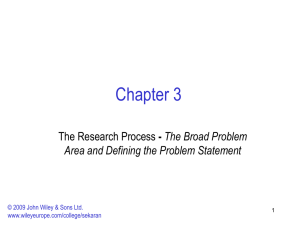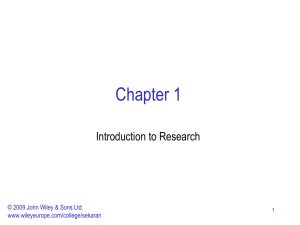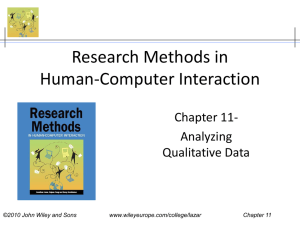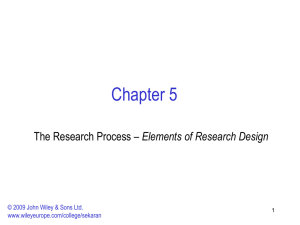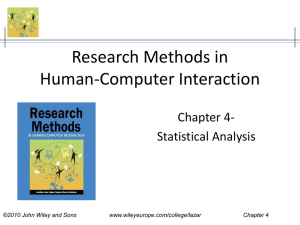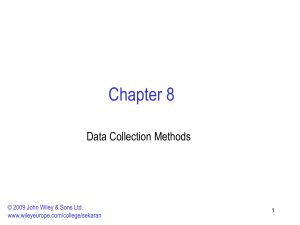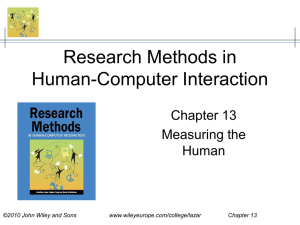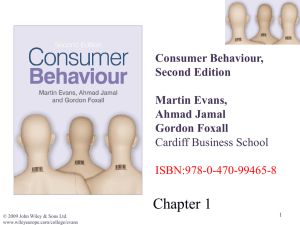ch01 - Interactive Computing Lab
advertisement
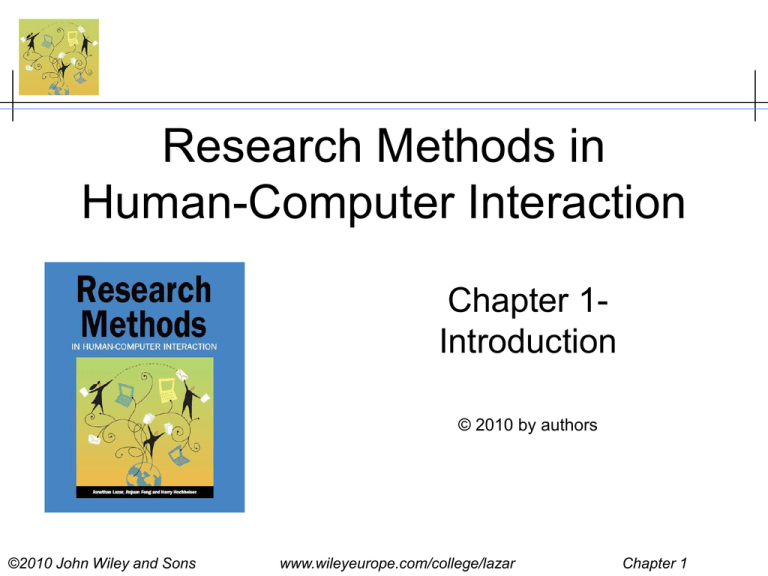
Research Methods in Human-Computer Interaction Chapter 1Introduction © 2010 by authors ©2010 John Wiley and Sons www.wileyeurope.com/college/lazar Chapter 1 History of HCI Research • The first HCI conference was held in 1982 • But other work was going on before 1982 – Conferences such as HFES – Books such as “Software Psychology” – Work at governmental agencies (e.g. SSA) – “Office automation” research • The name “human-computer interaction” or “computer-human interaction” was first applied to the 1982 conference ©2010 John Wiley and Sons www.wileyeurope.com/college/lazar Chapter 1 Why was HCI needed? • In the late 1970s and early 1980s, there was a shift: – From large computers in secured rooms, operated only by engineers – To small computers, operated by people without a technical background, in homes and workplaces • Ease of use, the human side, user acceptance, all became more important! ©2010 John Wiley and Sons www.wileyeurope.com/college/lazar Chapter 1 Changes in HCI research • The main topics of HCI have shifted over time: • 1980s – Word processing and database interfaces • 1990s – Web usability, e-mail, groupware • 2000s – User-generated content, tagging, social networking ©2010 John Wiley and Sons www.wileyeurope.com/college/lazar Chapter 1 HCI Research • HCI research is at the intersection of rigor and relevance – There must be a good base of theory, and the research methods must be rigorous – There must be practical implications, simply influencing theory is not sufficient • Historically, HCI work has focused on practical results that improve the quality of life ©2010 John Wiley and Sons www.wileyeurope.com/college/lazar Chapter 1 HCI Research • HCI research involves a number of different disciplines: – Computer science – Management – Cognitive psychology – Library science – Communication – Design • It’s always going to be complex, and there will always be many different approaches ©2010 John Wiley and Sons www.wileyeurope.com/college/lazar Chapter 1 Measurement in HCI • There are many different approaches to measurement • The traditional measurements are: – Task performance, time performance, and user satisfaction • Those measurements do not accurately measure: – Why people no longer use an interface – Discretionary use for enjoyment (e.g. YouTube) – Emotion and trust ©2010 John Wiley and Sons www.wileyeurope.com/college/lazar Chapter 1 New forms of measurement • • • • • • A feeling of community? Emotion? Enjoyment? Physiological measures (EEG, EMG)? Lower carbon footprint? Satisfaction from accomplishments in gaming or in virtual worlds? • Ease of use and enjoyment of new forms of technology can be challenging to measure ©2010 John Wiley and Sons www.wileyeurope.com/college/lazar Chapter 1 Triangulation • No data collection method will be perfect • It is important to have multiple researchers, using multiple methods, investigating the same phenomenon • We call this triangulation • One paper ≠ scientific truth • Different researchers, different methods, all coming to the same conclusion, THAT’S when you find consensus ©2010 John Wiley and Sons www.wileyeurope.com/college/lazar Chapter 1 Consensus in research • Many core questions in HCI remain unanswered – What is the minimum number of people required for usability testing? • Or the answers change over time due to changing technology – What is the biggest frustrations for users on the web? (download speed? Viruses? Browser compatibility?) ©2010 John Wiley and Sons www.wileyeurope.com/college/lazar Chapter 1 Consensus in research • One area where there is clear consensus in the HCI research: – Broad, shallow tree structures (c) in information spaces are superior to narrow, deep structures (a and b) (a) (b) (c) – Multiple researchers and methods have established this ©2010 John Wiley and Sons www.wileyeurope.com/college/lazar Chapter 1 Inherent conflicts in HCI • HCI research is complex • There often is not one optimal solution • There are trade-offs and multiple stakeholders with conflicting goals – Users prefer consistency over change – Often, there is a trade-off between usability and security (the highest ease of use would be with no security, which isn’t possible) – HCI research can be hard to cost-justify ©2010 John Wiley and Sons www.wileyeurope.com/college/lazar Chapter 1 Interdisciplinary nature • HCI research involves many disciplines: – Human factors, engineering, psychology (were heavily involved from the start) – Art and design, library and information science (very involved right now) • Each discipline has a tradition of research methods • These methods are modified for use in HCI research, some new ones are created ©2010 John Wiley and Sons www.wileyeurope.com/college/lazar Chapter 1 Interdisciplinary nature • We have a long history of controlled studies in laboratories measuring task and time performance from psychology and engineering • As new technologies are developed involving communication, socializing and emotion, we need to modify and use methods from the social sciences • New approaches to research, and multimethod research, is needed ©2010 John Wiley and Sons www.wileyeurope.com/college/lazar Chapter 1 Interdisciplinary research • Interdisciplinary research can be challenging – Focus on journals vs. conferences – Single author vs. group author publications – Focus on theory vs. applied, practical work – Focus on grant money vs. anti-grant money – Some disciplines are very self-reflective – Even the appropriate attire varies • This is true even if all disciplines call themselves “HCI researchers” ©2010 John Wiley and Sons www.wileyeurope.com/college/lazar Chapter 1 Different Focus on each step • Different disciplines may focus more on one step of the research process than others – Theory – Research Methods – Participants/context – Statistics/analysis – Implications for interfaces • We expect this comment to be somewhat controversial, but based on our experience, we believe strongly that it is true ©2010 John Wiley and Sons www.wileyeurope.com/college/lazar Chapter 1 Communicating your ideas • You need to be familiar with research methods from different disciplines • Know what the “sensitive spots” are from other disciplines • You need to communicate your results in a way that others can understand • People from other disciplines will be reviewing your paper or your grant • Be prepared to answer: “why did we use method X instead of methods Y or Z?” ©2010 John Wiley and Sons www.wileyeurope.com/college/lazar Chapter 1 Research and Usability Testing • Is usability testing the same as research? • The methods used in UT and research can be the same (experimental model, task and time measurements, lab setting) • The GOALS of UT and research are often different: – UT: find and fix flaws in specific interfaces, using any method needed, and few users – Research: larger number of users, results that can be generalized – For more information on differences, see chapter 10 ©2010 John Wiley and Sons www.wileyeurope.com/college/lazar Chapter 1 End-of-chapter • Summary • Discussion questions • Research design exercise ©2010 John Wiley and Sons www.wileyeurope.com/college/lazar Chapter 1
